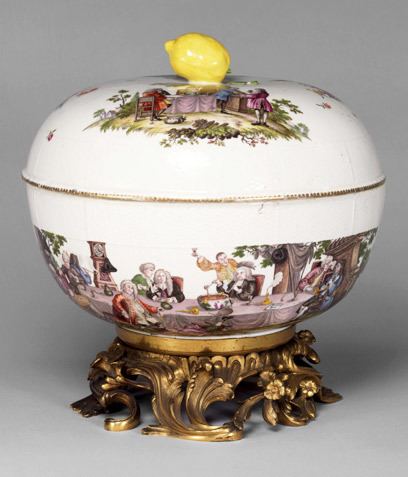 | ||
A punch bowl is a bowl, often large and wide, in which the drink punch is served.
Contents
Origins
The word punch is a loanword from Hindi. The original drink was named paantsch, which is Hindi for "five", and the drink was made from five different ingredients: spirit, sugar, lemon, water, and tea or spices. The drink was brought back from India to England by the sailors and employees of the British East India Company in the early seventeenth century, and from there it was introduced into other European countries.
Punch bowls
Punch quickly became a popular drink. It was served in punch bowls, usually ceramic or silver, which were often elaborately decorated. Punch bowls sometimes had lids or were supported on a stand; other accessories such as a serving ladle and cups in which to serve the drink sometimes accompanied the punch bowl. Punch bowls were often painted with inscriptions or were used for testimonial purposes: the first successful whaling voyage from Liverpool was commemorated by a punch bowl presented by the owners of the ship to its captain.
The ubiquity of the punch bowl as a household item is illustrated in this 1832 quote:
The punch-bowl was an indespensible vessel in every house above the humblest class. And there were many kindly recollections connected with it, it being very frequently given as a present. No young married couple ever thought of buying a punch-bowl; it was always presented to them by a near-relative.
Occasionally less likely vessels were used as punch bowls:
On the 15th October 1694 Admiral Edward Russell, then commanding the Mediterranean fleet, gave a grand entertainment at Alicante. The tables were laid under the shade of orange-trees, in four garden-walks meeting in a common centre, at a marble fountain, which last, for the occasion, was converted into a Titanic punch-bowl. Four hogsheads of brandy, one pipe of Malaga wine, twenty gallons of lime-juice, twenty-five hundred lemons, thirteen hundredweight of fine white sugar, five pounds' weight of grated nutmegs, three hundred toasted biscuits, and eight hogsheads of water, formed the ingredients of this monster-brewage. An elegant canopy placed over the potent liquor, prevented waste by evaporation, or dilution by rain; while, in a boat, built expressly for the purpose, a ship-boy rowed round the fountain, to assist in filling cups for the six thousand persons who partook of it.
Particular punch bowls
Other uses
At times, punch bowls were used as baptismal fonts in dissenting families.
The American poet Oliver Wendell Holmes wrote the poem On Lending a Punch-bowl about an old silver punch bowl.
In English usage, large, bowl-shaped landscape features (often the head of combes or valleys) were occasionally given the name punch bowl, such as the Devil's Punch Bowl in Surrey or Punchbowl Crater ("The Punchbowl") on the island of Oahu in Hawaii.
